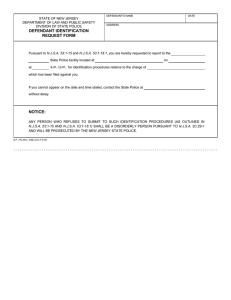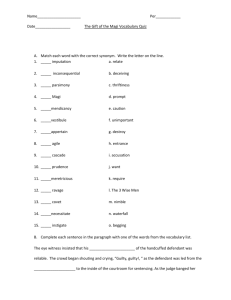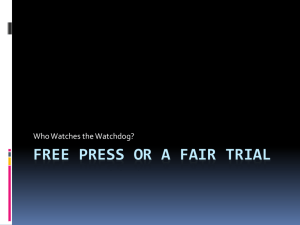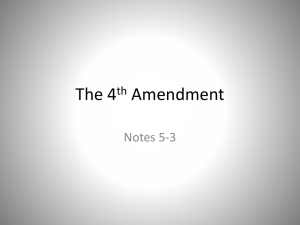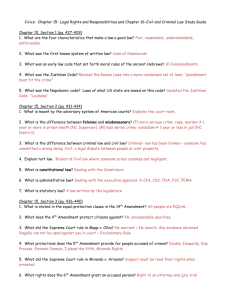IN THIS ISSUE
advertisement
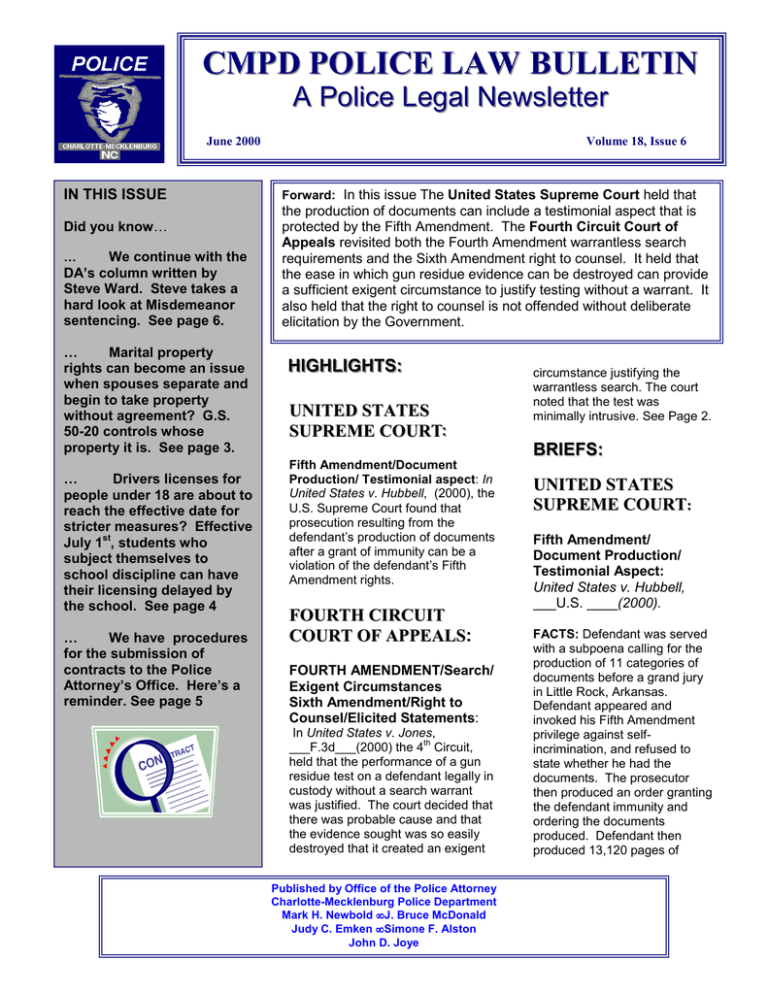
CMPD POLICE LAW BULLETIN A Police Legal Newsletter June 2000 IN THIS ISSUE Did you know… … We continue with the DA’s column written by Steve Ward. Steve takes a hard look at Misdemeanor sentencing. See page 6. … Marital property rights can become an issue when spouses separate and begin to take property without agreement? G.S. 50-20 controls whose property it is. See page 3. … Drivers licenses for people under 18 are about to reach the effective date for stricter measures? Effective July 1st, students who subject themselves to school discipline can have their licensing delayed by the school. See page 4 … We have procedures for the submission of contracts to the Police Attorney’s Office. Here’s a reminder. See page 5 Volume 18, Issue 6 Forward: In this issue The United States Supreme Court held that the production of documents can include a testimonial aspect that is protected by the Fifth Amendment. The Fourth Circuit Court of Appeals revisited both the Fourth Amendment warrantless search requirements and the Sixth Amendment right to counsel. It held that the ease in which gun residue evidence can be destroyed can provide a sufficient exigent circumstance to justify testing without a warrant. It also held that the right to counsel is not offended without deliberate elicitation by the Government. H HIIG GH HLLIIG GH HTTS S:: UNITED STATES SUPREME COURT:: circumstance justifying the warrantless search. The court noted that the test was minimally intrusive. See Page 2. BRIEFS: Fifth Amendment/Document Production/ Testimonial aspect: In United States v. Hubbell, (2000), the U.S. Supreme Court found that prosecution resulting from the defendant’s production of documents after a grant of immunity can be a violation of the defendant’s Fifth Amendment rights. FOURTH CIRCUIT COURT OF APPEALS: FOURTH AMENDMENT/Search/ Exigent Circumstances Sixth Amendment/Right to Counsel/Elicited Statements: In United States v. Jones, th ___F.3d___(2000) the 4 Circuit, held that the performance of a gun residue test on a defendant legally in custody without a search warrant was justified. The court decided that there was probable cause and that the evidence sought was so easily destroyed that it created an exigent Published by Office of the Police Attorney Charlotte-Mecklenburg Police Department Mark H. Newbold • J. Bruce McDonald Judy C. Emken • Simone F. Alston John D. Joye UNITED STATES SUPREME COURT: Fifth Amendment/ Document Production/ Testimonial Aspect: United States v. Hubbell, ___U.S. ____(2000). FACTS: Defendant was served with a subpoena calling for the production of 11 categories of documents before a grand jury in Little Rock, Arkansas. Defendant appeared and invoked his Fifth Amendment privilege against selfincrimination, and refused to state whether he had the documents. The prosecutor then produced an order granting the defendant immunity and ordering the documents produced. Defendant then produced 13,120 pages of documents and testified that was all in his control. Subsequently, the prosecutor used the documents’ contents in an investigation that led to an indictment of the defendant on tax and fraud charges. government could not make that showing and thus the case was dismissed. The subpoena, as the District Court put it, was a fishing expedition. ISSUE: Whether or not the Defendant’s production of the documents was a testimonial act protected by the Fifth Amendment? FOURTH CIRCUIT COURT OF APPEALS: RULE: YES. A broadly worded request for production of documents that requires a Defendant to confess to the existence of documents violates the Fifth Amendment. DISCUSSION: The Fifth Amendment, in part, says no person shall be “compelled in any criminal case to be a witness against himself….” The Court reaffirmed the notion that while acts are not necessarily testimonial simply because they are incriminating, acts that require the defendant to admit to knowledge and or control are testimonial in nature. In this case, the Government issued a subpoena that was extremely broadly worded and required the Defendant to assemble hundreds of pages. In cataloging and producing the required documents, the defendant admitted to the existence of these documents and his control of them. The production of these documents provided the vital link needed to prosecute the defendant. For the government to be allowed to use the material against the Defendant, it must be able to show that the information was obtained wholly independent of the testimonial aspect of the Defendant’s act of production. To do that, the government must show with reasonable particularity that it already knew of the existence of the documents and the Defendant’s possession of them. The Fourth Amendment/Search/ Exigent circumstances Sixth Amendment/Right to Counsel/Elicited Statements: United States v. Jones, ___ F.3d _______(2000) FACTS: Defendant was suspected of a murder in which two masked gunmen entered the victim’s home and shot the victim to death. The mother of the victim indicated to detectives that Jones may have been involved because he had a dispute over a woman with the victim. Other witnesses indicated that one of the gunmen wore a multicolored shirt and gave a physical description of the gunman. The detective also received an anonymous call that said Jones was involved and that masks and guns could be found at his home. The Detective located a one year old unrelated Malicious Destruction of Property arrest warrant for Jones and arrested Jones at his home. Jones was wearing a multicolored shirt and matched the physical description. The detective requested a gunshot residue (GSR) test to be conducted on Jones. This test was conducted on Jones without a search warrant first being obtained. On March 6, 2 1997,Jones was being held in federal custody awaiting trial for the murder. A co-defendant, Daniel Ross had already pled guilty under an agreement in which he was to testify against Jones. Inadvertently, Ross was transferred to the same detention center as Jones, actually sharing the same housing unit. During this time, Jones spoke to Ross and said that the prosecution would be unable to identify him “because we were wearing masks.” Ross testified against Jones in trial using the statement. Ross also testified that he did not remember initiating any of the conversations he had with Jones while in custody awaiting Jones’ trial. ISSUE: 1) Whether the GSR test was done in violation of the Fourth Amendment? 2) Whether the statement testified to by Ross was obtained in violation of the Sixth Amendment? RULE 1: No. A warrantless GSR test is justified if police have probable cause and exigent circumstances. RULE 2: No. A statement that is not deliberately elicited by the government does not violate the Sixth Amendment. DISCUSSION: 1) The GSR was a search and as such must be justified under the Fourth Amendment. Generally, a warrant based on probable cause must be obtained by police before a search may be conducted. In this case, the Court found that the detective did have probable cause based on the information given by the victim’s mother, the similarities between the witness descriptions and Jones, and the anonymous call. Additionally, the Court found that the ease in which the evidence can be destroyed, through a mere hand washing, created an exigent circumstance that justified the search without a warrant. Crucial to this finding was the unobtrusiveness of the test. Nothing more than a swabbing of between the fingers is required. More intrusive searches may require a greater exigency. Jones argued that because he was in custody on an unrelated charge, the search was a th violation of the 4 Amendment. The court merely commented on the legality of the arrest and analyzed the search under warrantless search rules. 2) The Sixth Amendment prohibits police from initiating contact with a Defendant once he has been formally charged with a crime. The Sixth Amendment applies here because Jones had been formally charged and was in custody awaiting trial. While Ross was placed in the same housing unit as Jones by the government, all evidence indicated that this was done completely by accident. The prosecutor even testifying that [the placement] “came as a…surprise” and that Ross had been given no instructions to elicit information from Jones. For there to be an actionable violation of the Sixth Amendment, there must be deliberate elicitation on the part of the Government. Since there are no indicia of Government cooperation with Ross to deliberately elicit information in the absence of counsel, the use of the statement at trial was proper. MARITAL PROPERTY RIGHTS IN NORTH CAROLINA Police Officers are faced with more legal issues in the performance of their duties now than ever before. The growing domestic law area is becoming a constant source of new challenges for law enforcement. With increasing rates of separation and divorce, it is easy for officers to become entangled in heated exchanges between separating spouses over the division of property. In order to assist officers in understanding the property rights of spouses, and to thereby aid officers in taking action appropriate to different situations, N.C.G.S. Section 50-20 is relayed here, in part, with brief explanation. North Carolina is neither a community property nor a title property state. Using those terms causes confusion in understanding North Carolina law. N.C.G.S. Section 50-20 lays out its own scheme for property division. The statute controls eventual property division so long as the Divorce is not final before one of the spouses file for equitable distribution, otherwise the title system controls. The statute is subject to many exceptions and the portions cited here are only to give officers a general understanding of property rights in divorce. Of special note to law enforcement in this area are the knowledge and ownership requirements for the crimes of larceny, damage to real or personal property, and trespass. Remember, for a taking to be a larceny, the person had to know that they were not entitled to the property. For the crimes of damage to property, the property damaged has to be the property of another. For regular trespass, the premises entered must be the premises of another. Domestic criminal trespass and common-law forcible trespass do not have the ownership requirements, however they both require there be a lawful or 3 peaceable occupant. Ownership and possessory rights over the property of two people in the process of separation and divorce are not clear and are the subject of a pending court hearing. Claims made by either spouse are subject to court revision. This makes the prosecution of crimes requiring the establishment of ownership far more difficult. Officers should consider the uncertainty of ownership and its disruptive effect on criminal prosecution in deciding what action to take. The best remedy for property crimes might well be civil. Crimes against the person are not effected by these property questions and officers should follow Department domestic violence policy for them. The following statutory cites are the framework that courts follow in dividing the property. G.S. 50-20(b): (1) Marital Property: All property gained by either spouse during the marriage. . (2) Separate Property: All property gained by a spouse before marriage. Also includes gifts or bequests given to a specific spouse during the marriage. Gifts from spouse to spouse are separate only if that was stated in the giving. (3) Divisible Property: Appreciation or diminution of marital property during the separation period. G.S. 50-20(c): All marital and divisible property will be equally divided. Courts can distribute unequally if it is more equitable. (c11a) is a factor to decide what is equitable. (c11a): Acts of either party to maintain, preserve, develop, expand; or to waste, neglect, devalue, or convert the marital property, during period of separation. G.S. 50-20(d): Spouses may divide their own marital property by written agreement. G.S. 50-20(i): Spouses may file a motion to prevent the other spouse from damaging, neglecting or taking property during the separation. G.S. 50-20(i1): Courts may make an interim distribution pending final distribution. Case law indicates that property titled jointly is rebuttably presumed to be a gift to the marriage. The creation of a joint account implies the consent for each spouse to use the funds for a marital purpose. The case law in this area is highly fact specific. Officers should be aware that even property that clearly came from a separate source could later be found to have been donated to the marriage. These are a sampling of the most relevant statutes; the total law on the subject is far greater. PROVISIONAL DRIVER’S LICENSE IN N. C. Effective July 1, 2000, N.C.G.S. Section 20-11 activates the last of the enhanced requirements for those under 18 to be licensed to drive. This is a brief recap of the basic requirements with the soon to be effective provisions included. The new provisions add to what is required for a person without a High School diploma to obtain a license. Without a diploma, one must obtain a Driving Eligibility Certificate before a driver’s license of any type may be issued. These certificates must be obtained from the head of the school attended by the minor. Previously, these certificates were issued if the minor was currently enrolled and attending school or such attendance was not possible, or to deny the minor a license would cause a substantial st hardship. As of July 1 , 2000, the certificates will issue in the same manner as before with an additional waiting period for students who have been suspended for more than 10 consecutive days in connection with the following conduct: 1) Possession or sale of alcohol or illegal controlled substance on school grounds; 2) Possession of firearm or explosive at school. Public schools must suspend for 1 year, if private schools take no action, this section is still activated. 3) Physical assault of school personnel on school property. Students who fall into the above category cannot be issued an eligibility certificate for at least one year after the conduct. Longer waits may apply. Special need based exceptions are possible. st As of July 1 , 2000, to receive a driver’s license under the age of 18 a person must: 1) 2) 3) Drive under a limited learner’s permit for 12 mos. And then Drive under a limited provisional license for 6 mos. And then Apply for a full provisional license. 4 Limited Learner’s Permit Requirements: 1) Complete Driver’s Ed. 2) Pass the written test 3) Provide an eligibility cert. Or Diploma 4) Eligibility certificate subject to delay by discipline problems This Allows: A minor may drive a supervising driver and only a supervising driver in the front seat, all passengers must wear a seat belt, and they may only drive 5 AM to 9 PM for the first 6 mos. Limited Provisional License Requirements: 1) Limited Learners Permit for 12 mos. 2) Have no moving violations within 6 mos. 3) Pass the road test This Allows: A minor may drive alone from 5 AM to 9 PM or to work, and may drive anytime with a supervising driver in the front, everyone seat belted. Full Provisional License Requirements: 1) Limited Provisional License for 6 mos. 2) No moving violations in previous 6 mos. This allows full driving privileges. Supervising Driver A parent or someone approved of by parent who has had a driver’s license for 5 years and has signed the learner’s application. Maximum two drivers. NEW! – Contract Procedures These new procedures apply to all contracts executed by or on behalf of the Charlotte Mecklenburg Police Department that meet the following criteria: Ø Contracts requiring the signature of the Chief of Police or his or her designee. Ø Contracts over $10,000.00 Ø All contract amendments, modifications and renewals. Ø All leases or other contracts concerning real property. These procedures do not apply to contracts for technology or technological services. I need a contract – what do I do next? 1. Determine the type of contract involved (goods, services, mixed goods & services, construction, lease). 2. Determine the contract amount. 3. Select the vendor, service provider or lessor 4. Prepare a draft of the contract using an approved contract template (available from the Police Attorney’s Office). • Do not sign a contract submitted by the vendor unless it has been reviewed and approved by the Police Attorney’s Office. 5. Consult with the Police Attorney’s Office concerning negotiations with the other party. • • • Changes proposed by the other party which affecting insurance, liability, warranties, renewal or termination must be reviewed by the Police Attorney’s Office. Non-material changes to the contract proposed by the other party may be approved by the division involved with the contract. If the other party’s attorney becomes involved, further negotiation of the contract should be referred to the Police Attorney’s Office. 6. If the contract has not previously been reviewed, send it to the Police Attorney’s Office. All contracts subject to these procedures must be reviewed prior to signing. 7. Remember to provide a copy of the contract, all attachments and/or bid specifications, and all previous and/or proposed amendments. 8. Once approved, three contracts with original signatures must be executed. • 1 original should be returned to the other party, 1 original should be kept by the CMPD, and 1 original should be forwarded to the City Clerk. • A copy of the contract should be forwarded to the Police Attorney’s Office. • The division or service area seeking 5 the contract is responsible for tracking the contract including, all amendments, modifications, renewals and termination of the contract. Other Considerations • • • Contract renewal -- A ‘Request for Renewal’ shall be sent to the Police Attorney’s Office at least 60 days prior to the expiration of the contract. Retroactive contracts – The division or service area seeking the contract assumes full responsibility for the terms and conditions of the contract. Contract Limits Ø $10,000.00 or less – Chief or his authorized designee may sign. Ø More than $10,000.00 but less than $50,000.00 – Chief must sign. Ø More than $50,000.00 but less than $100,000.00 – City Manager or Asst. must sign. Ø More than $100,000.00 must be awarded by City Council. Following formal approval by City Council the contract may be signed by the Chief or the City Manager. “THE DISTRICT ATTORNEY’S CORNER” Written and edited by Steve Ward, DA Liaison to CMPD When you go to District Court don’t the Sentences seem light to you? It looks like the Judges are just slapping these people on the wrist! But do you understand the Sentencing guidelines? Have you ever considered that there is not much more they can do? Read this and maybe it will open your eyes! STRUCTURED SENTENCING FOR MISDEMEANORS I. Structured Sentencing The Structured Sentencing Act, NCGS Section 15A1340.10 et seq. governs the sentencing of all criminal offenses in North Carolina (other than Driving While Impaired) committed after October 1, 1994. Structured Sentencing provides consistency for the same crime and ensures that any defendant receiving an active prison term will indeed serve at least the minimum of the sentencing range for that particular crime. II. Misdemeanor Sentencing There are separate sentencing guidelines for felony and misdemeanor crimes. The Misdemeanor Punishment Guidelines group misdemeanants based on the class of the misdemeanor conviction and the number of prior convictions. The range of the sentence length (time) which may be imposed and the type of sentence that may be imposed (active, intermediate, or community punishment), are then calculated. III Misdemeanor Classes Every misdemeanor is referred to as either a Class A1, Class 1, Class 2, or Class 3 misdemeanor. Common examples are as follows: Class A1: Assault on a Child under 12; Assault on Government Official; Assault On a Female Class 1: Communicating Threats; Misdemeanor Death by Vehicle; Contributing to the Delinquency of a Minor; False Imprisonment; Larceny; Loitering for Prostitution; Possession of Drug Paraphernalia; Driving While License Revoked; Possession of Marijuana ½ to 1 ½ ounce. Class 2: Harassing Phone Calls; Reckless Driving; Indecent Exposure; Most Worthless Checks; Disorderly Conduct; Carrying a Concealed Weapon; Resisting. First Degree Trespass. Class 3: Unlawful st Concealment (1 offense); Intoxicated and Disruptive; Possession of less than ½ ounce nd Marijuana; 2 Degree Trespass 6 IV. Prior Conviction Levels There are three prior conviction levels for misdemeanor sentencing, based on the number of prior convictions. These are as follows: (a) Level I – offender has 0 (zero) prior convictions; (b) Level II - offender has 1 – 4 prior convictions; (c) Level III – offender has 5 or more prior convictions. If an offender is convicted of several charges on the same day in district court, this is considered as one prior conviction. Several felony convictions during a single week of superior court also count as one prior conviction. Infractions (speeding, expired tags, etc.) do NOT count as prior convictions. The State must produce reliable and competent evidence of the prior conviction. V. Sentence: Length Based on the Sentence Range It is within the judge’s discretion as to whether a sentence is to be Active or Suspended, within the range of the sentencing chart. No misdemeanors (other than DWI) carry a mandatory active sentence. VI. Types of Sentence Dispositions There are three possible sentence “dispositions” for misdemeanor convictions: A. “A” – indicates an Active sentence as punishment, requiring the offender to serve the specified term of incarceration. B. “I” – indicates an Intermediate punishment which places the offender on supervised probation and includes (1) a split sentence; (2) house arrest;(3) participation in a residential treatment program; (4) intensive probation; or (5) assignment to a daily reporting center. Intermediate punishment may also include additional sanctions found under the Community punishment category. C. “C” – indicates a Community punishment. This category encompasses any authorized sentence that does not include active jail time or an intermediate sanction. Examples include supervised or unsupervised probation; outpatient drug/alcohol treatment; community service; restitution; and/or fines. two of the Class A1 misdemeanors.) In this scenario additional misdemeanors would not increase the severity of penalty. When a defendant is sentenced to an active punishment, he must serve the term of the imprisonment imposed. THERE IS NO PAROLE IN NORTH CAROLINA! A defendant can “earn time” not to exceed four days credit per month of incarceration according to the rules adopted by the Secretary of Corrections. VI. Limits on Sentences A judge can only impose a cumulative sentence that does not exceed twice the maximum sentence authorized for class and prior conviction level of the most serious offense. Example: Defendant is charged with AOF, AOG, Assault on a Child, DWLR, Communicating Threats, and Intoxicated and Disruptive. The facts of the case are very bad, but the defendant has no prior Convictions. The worst sentence he can get is 120 days active (60 days for 7 Misdemeanor Sentence Disposition and Prison/Jail Term Range Misdemeanor Class (Fine) Class A1 (fine discretionary) Class 1 (fine discretionary) Class 2 (maximum fine ($1,000) Class 3 (maximum fine $200) Level I: No Prior Convictions Level II: 1 to 4 Prior Convictions C/I/A 1—60 days C 1—45 days C 1—30 days C 1—10 days C/I/A 1—75 days C/I/A 1—45 days C/I 1—45 days C/I 1—15 days 8 Level III: 5 or More Prior Convictions C/I/A 1—150 days C/I/A 1—120 days C/I/A 1—60 days C/I/A 1—20 days

